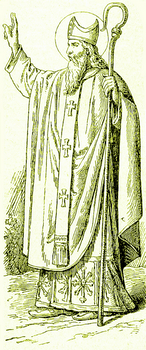Lives of the Saints
Our Models and Protectors
Spiritual Bouquet:
January 10

Saint William
Archbishop of Bourges
(† 1209)
William Berruyer, of the illustrious family of the ancient Counts of Nevers, was educated by Peter the Hermit, Archdeacon of Soissons, his maternal uncle. From his early childhood Saint William learned to despise the folly and emptiness of the world, to abhor its pleasures, and to tremble at its dangers. His only delight was in exercises of piety and his studies, with which he employed his whole time in an untiring application.
Saint William was made a canon, an ecclesiastic attached to a cathedral church, first at Soissons and afterwards in Paris; but he soon resolved to abandon the world and retired into the solitude of Grandmont, where he lived with great regularity in that austere Order. Finally he joined the Cistercians, flourishing with sanctity at the time, and later was chosen to be Prior of the Abbey of Pontigny, then made Abbot of Challis.
On the death of Henri de Sully, Archbishop of Bourges, William was chosen to succeed him. The announcement of this new dignity which had fallen on him overwhelmed him with grief, and he would not have accepted the office had not the Pope and his own Cistercian General, the Abbot of Citeaux, commanded him to do so. His first care in his new position was to conform his life to the most perfect rules of sanctity. He redoubled all his austerities, saying it was incumbent on him now to do penance for others as well as for himself. He always wore a hair shirt under his religious habit, and never added to his clothing in winter or diminished it in summer; he never ate any flesh meat, though he had it at his table for guests.
When he drew near his end, he was, at his request, laid on ashes in his hair cloth, and in this posture expired on the 10th of January, 1209. While this holy bishop was laid out for veneration, an infirm young boy who wanted to venerate him, but had to be carried to the church by his mother, was completely cured of his infirmities, and ran about proclaiming the miracle. The stone of his tomb in the Cathedral Church of Bourges cured mortal wounds and illnesses and delivered possessed persons; the deaf and dumb, the blind, the mentally ill became sound. So many miracles occurred there that the monks could not record them all, and he was canonized nine years after his death, in 1218, by Pope Honorius III.
Reflection. The champions of faith prove the truth of their teaching no less forcefully by the holiness of their lives than by the power of their arguments. Never forget that to convert others we must first see to our own soul.
Little Pictorial Lives of the Saints, a compilation based on Butler's Lives of the Saints and other sources by John Gilmary Shea (Benziger Brothers: New York, 1894); Les Petits Bollandistes: Vies des Saints, by Msgr. Paul Guérin (Bloud et Barral: Paris, 1882), Vol. 1